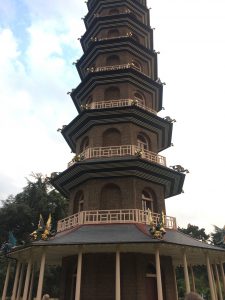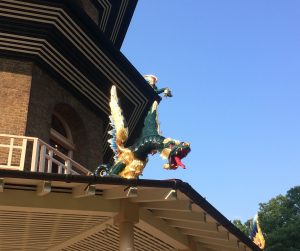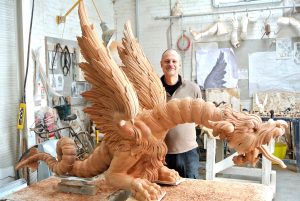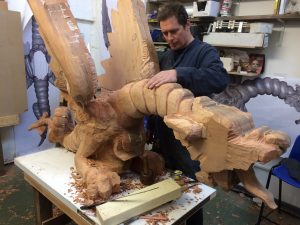The Art School’s Head of Historic Carving, Tim Crawley, has been at the centre of a major renovation project on the Great Pagoda at Kew Gardens. The restored pagoda was re-opened to the public on 13th July.


When originally built in 1763, each corner of the eaves of this octagonal structure was adorned with highly polychromed dragons varying in length from around five feet at the top of the tapering tower, to around eight feet at the bottom. In the 1780’s the dragons were removed. Tim was selected to design a new set of dragons to be reinstated on the building. The original colour scheme of the building was reinstated, with the dragons painted in iridescent glazes with gilded highlights.
A host of carvers worked on the project which required 80 new dragons to be crafted, and a number of carving tutors and alumni from City & Guilds of London Art School were commissioned to carve the sculptures. 72 of the dragons were 3D printed and eight carved from African Red Cedar wood.
In creating the design of the new dragons, Tim researched the original dragon designs with reference to engravings and paintings from the time of the construction and analysed similar works from the period. He then modelled prototypes in clay that were translated into full-size carvings by Art School alumnus Paul Jewby in his workshop in Suffolk. These carvings were then 3D scanned.


The 72 dragons that have been 3D printed are fixed to the top levels of the ten-storey structure whilst the eight pieces carved in the traditional manner adorn the lower storey. Art School alumni, John Shield assisted by David White, and Robert Randall (also the Art School’s de Laszlo Senior Wood Carving Tutor) assisted by Ashley Sands, David Mendieta and Sigridur Sigurdardottir were part of the team involved in carving the dragons.
Tim was selected to take a lead role in this restoration due to his projects restoring the architectural sculpture on such buildings as Temple Bar, St George’s Bloomsbury and King’s College Chapel, Cambridge. Commenting on the restoration, Tim says, “These ornamental dragons play a very significant part in the exotic effect of the building, with their dramatic silhouettes and sparkling finish, so it was important that they should be reinstated. It was also a wonderful opportunity for a large group of woodcarvers to work on this unusually grand architectural scale.”
A set of short videos following the creative process involved in recreating the dragons can be found here. The Art School’s Tim Crawley and Robert Randall are featured explaining their part in the restoration.
All tutors at the Art School are practising professionals working in their specialist fields. This can often lead to unique opportunities for students and recent alumni and also provides an important professional network on graduation. Recent Art School collaborations with important historic buildings includes the design and replacement of corbel heads and other restoration projects at Southwark Cathedral and the creation of grotesques to adorn St George’s Chapel, Windsor.
IMAGES
- Great Pagoda, Kew Gardens, featuring the new dragons
- One of the carved, wooden dragons
- Alumnus, John Shield
- Senior Woodcarving Tutor, Robert Randall
Images courtesy of Robert Randall.


